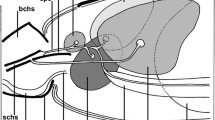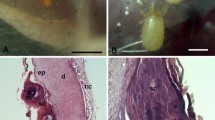Summary
The investigations with the stylostom were carried out on small-mammals and birds, the sucking-tube being unbranched and straight or curved. There are no differences in the development of the stylostom within the various kinds of hosts and the species of trombiculides.
On account of various specific stain-methods could be established, that the stylostom consists exclusively of congealed mite — secretion being rich of acid mucopolysaccharides. It is hyalineous and homogeneous and shows no cell-inclusions. The inner layer, surrounding the central-canal, colours differently, contrary to the exterior layer, as here the secretion is fluid.
Length-growth results from a step-wise filling of the saliva which congeals gradually; thus a ringlike structure arises in the hyalineous substance.
In the surroundings, mainly around the distal end of the tube, degenerated tissue can be seen: destructed leuko- and lymphocyts. This process of destruction, a kind of outside-pre-digestion is caused by another secretion, a lytic one, of the salivary gland.
The destructed host-tissue represents the food, independent of the kind of cells. No blood-sucking was observed.
A complete extra-intestinal digestion cannot be spoken of as only destructed cell-material was found in the lumen of the stylostom. Liquefication and final digestion takes place in the pharynx and esophagus of the larva.
The sucking-mechanism of the larva is described; Sucking and secretion-phase alternate.
The stylostom has the duty to guarantee the fixing of the parasite on the host, as well as to make possible the taking of food.
Zusammenfassung
Die Untersuchungen am Stylostom wurden an Kleinsäugern und Vögeln durchgeführt, wobei der Saugschlauch unverzweigt und gerade oder gebogen auftrat. Er bildet sich unabhängig von der Wirtsart und unabhängig von der Trombiculidenart gleich aus.
Es konnte auf Grund verschiedener spezifischer Färbemethoden erkannt werden, daß das Stylostom ausschließlich aus erstarrtem Milbensekret besteht, welches reich an sauren Mucopolysacchariden ist. Es erscheint hyalin und homogen und weist keine Zelleinschlüsse auf. Die innere Schicht, die den Zentralkanal umgibt, färbt sich im Gegensatz zur äußeren Schicht unterschiedlich an, da hier das Sekret im Sol-Zustand vorliegt.
Ein Längenwachstum erfolgt durch das schubweise Nachrinnen des Speichels, der nach und nach erstarrt; dadurch kommt in der hyalinen Masse eine „ringförmige Struktur“ zustande.
In der Umgebung, vor allem um das distale Ende des Schlauches, erkennt man degeneriertes Gewebe, zerstörte Leuko- und Lymphocyten. Dieser Zerstörungsprozeß, eine Art von Außenvorverdauung, wird durch ein anderes, ein lytisches Sekret der Speicheldrüsen hervorgerufen.
Als Nahrung dient dieses zerfallene Wirtsgewebe, unabhängig von der Zellart; es konnte kein Blutsaugen festgestellt werden.
Von einer vollständig extraintestinalen Verdauung kann nicht gesprochen werden, da im Lumen des Stylostoms nur zerstörtes Zellmaterial gefunden wurde. Die Verflüssigung und damit Endverdauung erfolgt erst im Pharynx und Oesophagus der Larve.
Der Saugmechanismus der Larve wurde beschrieben; es erfolgt ein Alternieren von Saug- und Sekretionsphase.
Das Stylostom hat die Aufgabe, die Verankerung des Parasiten mit dem Wirt zu gewährleisten sowie die Nahrungsaufnahme zu ermöglichen.
Similar content being viewed by others
Literatur
Allred, D. M.: Observations on the stylostome (feeding tube) of some Utah chiggers. Utah Acad. Sci. 31, 61–63 (1954).
André, M.: Digestion «extra-intestinale» chez le rouget (Lept. autumn. Shaw). Bull. Mus. Hist. nat. Paris 38, 509–516 (1927).
Arthur, D. R.: Ticks and disease. Int. Series of Monographis on pure and applied Biology. Div. Zoology 9 (1962).
Brown, J. R. C.: The feeding organs of the adult of the common chigger. J. Morph. 91 (I), 15–52 (1952).
Brug, S. L.: Chitinisation of parasites in mosquitos. Bull. Ent. Res. 23, 229–231 (1932).
Cross, H. F.: In vivo studies of tissue reaction in chicks resulting from the feeding by larvae of Trombicula splendens. J. Econ. Ent. 55, 22–26 (1962a).
— Dimensions of the clear areas in the skin of chicks that resulted from the feeding by larvae of two strains of Trombicula splendens at different periods. J. Econ. Ent. 55, 27–33 (1962b).
— Experiments with homogenates of larvae of Trombicula splendens. J. Econ. Ent. 55, 403–404 (1962c).
-- Observations on the formation of the feeding tube by Trombicula splendens larvae. Acarologia, fasc. h.s. 1964, 255–261.
Daniel, M.: Nase zkusenosti s trombidiosu (Erfahrung mit Trombidiosis). Čs. Parasit. 3, 25–31 (1956).
— Zur Frage des intradermalen Parasitismus und seine Morphologie bei Larven von Euschöngastia ulcerofaciens (Acari, Trombic.). Foliabiol., fasc., 6, 359–367 (1957).
— The bionomics and development cycle of some chiggers (Acariformes, Trombiculidae) in the Slovac Carpathians. Čs. Parasit. 8, 31–188 (1961).
Ewing, H. E.: The trombiculid mites and their relation to disease. J. Parasit. 30, 339 (1944).
Feng, L. C., Hoeppli, R.: Histological reactions in the skin due to ectoparasites. Nat. med. J. China 17, 541–556 (1931).
— On some histological changes caused by mites. Nat. med. J. China 47, 1191–1199 (1933).
Flögel, J. H.: Über eine merkwürdige, durch Parasiten hervorgerufene Gewebsneubildung. Arch. Naturgeschichte 42, 106 (1876).
Fuller, H. S.: Infestation of man in Burma with trombiculid mites, with special reference to Trombicula deliensis. Amer. J. Hyg. 45, 363–371 (1947).
Fuß, S., Hanser, R.: Über Trombidiosis. Arch. Derm. Syph. (Berl.) 167, 644–658 (1932).
Gudden, B.: Über eine Invasion von Leptus autumnalis. Virchows Arch. path. Anat. 52, 255–259 (1871).
Hecht, O.: Hautreaktionen auf die Stiche blutsaugender Insekten und Milben als allergische Erscheinungen. Zbl. Haut- u. Geschl.-Kr. 44, 241–255 (1933).
Jones, B. M.: The pentration of the host tissue by the harvest mite, Trombicula autumnalis Shaw. Parasitology 40, 247–260 (1950).
Jourdain, S.: Le styloprocte de l'uropode végétant et le stylostome des larvaes de Trombidion. Arch. Parasit. II, 1, 28–33 (1899).
— Les pièces buccales du Rouget de l'Homme. Arch. Parasit. II, 4, 633 (1899).
Kepka, O.: Die Trombiculinae (Acari, Trombiculidae) in Österreich. Z. Parasitenk. 23, 548–642 (1964).
Lavoipierre, M. M. J.: Some inclusions in the intestinal tract of trombiculid mites. Trans. roy. Soc. trop. Med. Hyg. 53, No. 1, 5 (1959).
Marshall, J. F., Staley, J.: A newly observed reaction of certain species of mosquitos to the bites of larval hydrachnids. Parasitology 21, 158–160 (1929).
Methlagl, A.: Über die Trombidiose in den österreichischen Alpenländern. Denkschr. Akad. Wiss. Wien, math.-nat. Kl. 101, 213–249 (1927).
Mitchell, R.: The anatomy of an adult chigger mite Blankaartia acuscutellaris (Walch). J. Morph. 114, 373–381 (1964).
Moorhous: Proceedings of the 2nd Internat. Congr. of Acarology, Sutton Bonigton, 19th–25th July 1967.
Obata, J.: Anatomical studies on Trombicula akamushi (Brumpt), the vector of Tsutsugamushi disease. Ei sei Dobutsu 5, 111–143 (1954).
Pick, F.: L'observation d'un syndrome cutane dû aux morsures de Trombicula autumnalis. Bull. Soc. path. exot. 45, 60–62 (1952).
Pflugfelder, O.: Zooparasiten. Jena: Fischer 1950.
-- Über eigenartige Abwehrreaktionen bei Milbenbefall. Mikrokosmos (1954).
Poulsen, P. A.: Studies on Trombicula autumnalis Shaw and trombidiosis in Denmark. Universitets forlaget i Aarhus 1957.
Schumacher, H. H., Hoeppli, R.: Histological reactions to Trombiculid mites, with special reference to “natural” and “unnatural” hosts. Z. Tropenmed. Parasit. 13, 419–428 (1962).
— Histochemical reactions to Trombiculid mites, with special reference to the strukture and function of the “stylostome”. Z. Tropenmed. Parasit. 14, 190–208 (1963).
Toldt, K.: Die „Schlernbeiße“ als Ausgangspunkt andauernder zoologisch-medizinischer Studien. Schlern H. 1 (1951).
Toomey, N.: Trombidiasis (Leptus autumnalis). Rev. urolog. cutan. (St. Louis) 25, 598–608 (1921).
Trouessart, E.: Note sur l'organe de fixation et de succion du Rouget (larve de Trombidion). Bull. soc. entomol. France 4, 97–102 (1897).
— Sur la piqûre du Rouget. Arch. Parasit. 2, 286–290 (1899).
Vitzthum, H.: Systematische Betrachtungen zur Frage der Trombidiose. Z. Parasitenk. 2, 2, 223–247 (1929).
Weyer, F.: Experimente zur Frage der transovariellen Übertragung von Rickettsien. Z. Tropenmed. Parasit. 13, 409–419 (1962).
Wharton, G. W.: Observations on the feeding of prostigmatid larvae (Acarina, Trombidiformes) on arthropods. J. Wash. Acad. Sci. 44, 244–245 (1954).
-- Fuller, H. S.: A manual of the chiggers. Entomol. Soc. Washington 4 (1952).
Winkler, A.: Neue Ergebnisse in der Trombidioseerforschung. I. Hautarzt 4, 135–138 (1953).
Author information
Authors and Affiliations
Additional information
Vorliegende Studie ist ein Teil der Dissertation, welche von der Philosophischen Fakultät der Universität Graz angenommen wurde.
Rights and permissions
About this article
Cite this article
Voigt, B. Histologische Untersuchungen am Stylostom der Trombiculidae (Acari). Z. F. Parasitenkunde 34, 180–197 (1970). https://doi.org/10.1007/BF00259695
Received:
Issue Date:
DOI: https://doi.org/10.1007/BF00259695




